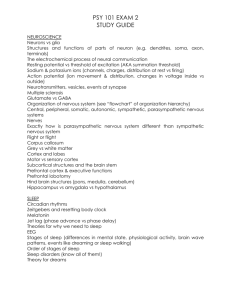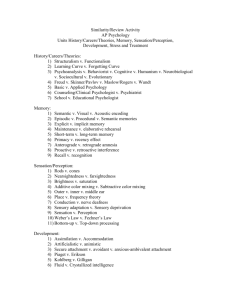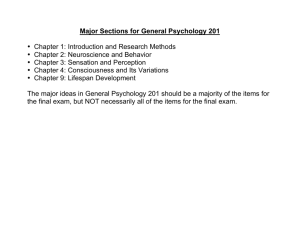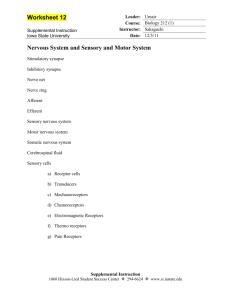develop - AP Psychology
advertisement
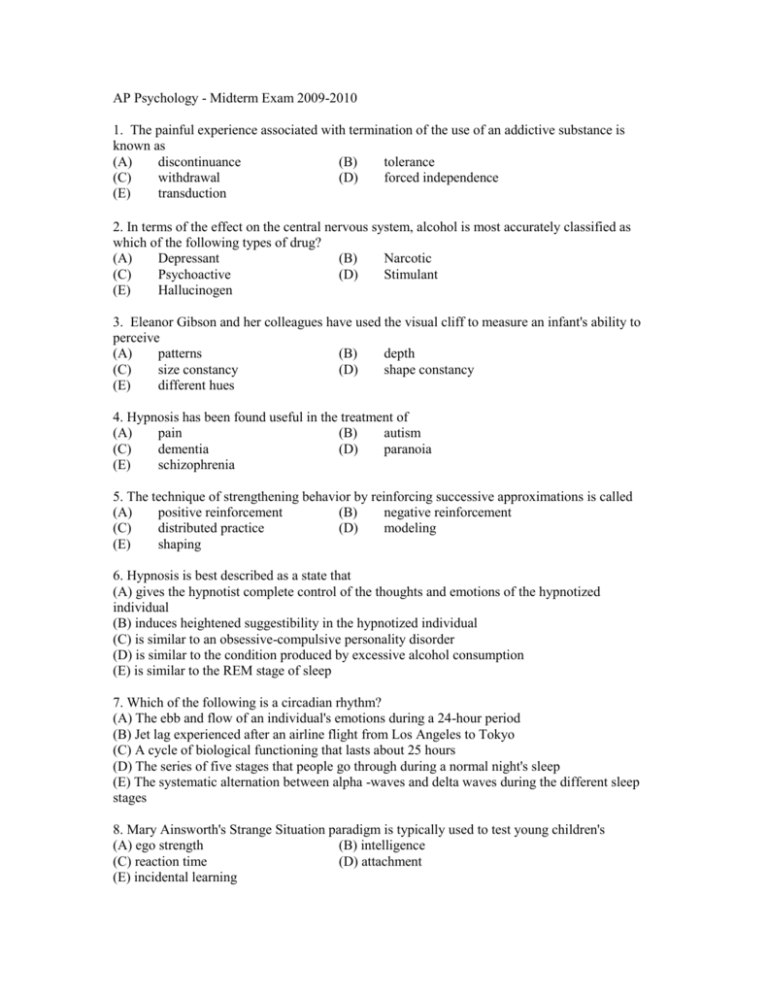
AP Psychology - Midterm Exam 2009-2010 1. The painful experience associated with termination of the use of an addictive substance is known as (A) discontinuance (B) tolerance (C) withdrawal (D) forced independence (E) transduction 2. In terms of the effect on the central nervous system, alcohol is most accurately classified as which of the following types of drug? (A) Depressant (B) Narcotic (C) Psychoactive (D) Stimulant (E) Hallucinogen 3. Eleanor Gibson and her colleagues have used the visual cliff to measure an infant's ability to perceive (A) patterns (B) depth (C) size constancy (D) shape constancy (E) different hues 4. Hypnosis has been found useful in the treatment of (A) pain (B) autism (C) dementia (D) paranoia (E) schizophrenia 5. The technique of strengthening behavior by reinforcing successive approximations is called (A) positive reinforcement (B) negative reinforcement (C) distributed practice (D) modeling (E) shaping 6. Hypnosis is best described as a state that (A) gives the hypnotist complete control of the thoughts and emotions of the hypnotized individual (B) induces heightened suggestibility in the hypnotized individual (C) is similar to an obsessive-compulsive personality disorder (D) is similar to the condition produced by excessive alcohol consumption (E) is similar to the REM stage of sleep 7. Which of the following is a circadian rhythm? (A) The ebb and flow of an individual's emotions during a 24-hour period (B) Jet lag experienced after an airline flight from Los Angeles to Tokyo (C) A cycle of biological functioning that lasts about 25 hours (D) The series of five stages that people go through during a normal night's sleep (E) The systematic alternation between alpha -waves and delta waves during the different sleep stages 8. Mary Ainsworth's Strange Situation paradigm is typically used to test young children's (A) ego strength (B) intelligence (C) reaction time (D) attachment (E) incidental learning 9. Which of the following will NOT increase behavioral. and mental activity? (A) Cocaine (B) Caffeine (C) Benzedrine (D) Amphetamines (E) Barbiturates 10. REM sleep, generally an "active" state of sleep, is accompanied by which of the following paradoxical characteristics? (A) Slowed heart rate (B) Slowed respiration rate (C) Lowered blood pressure (D) Lowered muscle tone (E) Reduced eye movements 11. A teacher who is mistakenly informed that a student is learning disabled begins to treat that student differently from others. The teacher does not call on the student in class or help her with challenging material. The student's grades gradually decline. This result is an example of which of the following? (A) Reactance (B) Social loafing (C) Actor-observer bias (D) Self-fulfilling prophecy (E) Fundamental attribution error 12. Individuals who accept personal responsibility for their life experiences may be characterized as having (A) unrealistic expectations (B) delusions of grandeur (C) an internal locus of control (D) a pessimistic view of reality (E) an introverted personality 13. A student participates in a month-long sleep study designed to examine free-running circadian rhythms. If all time cues are removed, the student's total sleep-wake cycle is likely to (A) average about 25 hours (B) average about 12 hours (C) average whatever it had averaged when the student began the study (D) become even more dependent than usual on the student's activity level (E) become extremely variable 14. According to attribution theory, Pablo is most likely to attribute his high score on a difficult exam to (A) good luck (B) his intelligence (C) his instructor's teaching ability (D) the low level of difficulty of the exam (E) his classmates' inadequate preparation for the exam 15. The result of the evolutionary process that preserves traits that enhance the adaptation of an organism and suppress traits that do not is called: (A) habituation (B) accommodation (C) natural selection (D) eugenics (E) species assimilation 16. The correlations between the IQ scores of identical twins reared apart are lower than those of identical twins reared together. This difference is best explained by which of the following? (A) Heredity plays an important role in determining IQ. (B) Environment plays an important role in determining IQ. (C) Heredity plays no role in determining IQ. (D) Environment plays no role in determining IQ. (E) Heredity and environment play an equal role in determining IQ. 17. Keisha was able to roll over at two months, crawl at five months, and walk at ten months. This sequence of development is most likely due to (A) egocentrism (B) social context (C) maturation (D) attachment (E) assimilation 18. A central nervous system depressant that produces a false feeling of well-being and efficiency and results in slower reaction time to stimulation is (A) cocaine (B) marijuana (C) dopamine (D) alcohol (E) nicotine 19. Which of the following reflects the inborn and stable rudiments of personality, such as excitability? (A) Imprinting (B) Social referencing (C) Individuation (D) Temperament (E) Accommodation 20. John B. Watson was a pioneer in which of the following perspectives of psychology? (A) Biological (B) Functionalism (C) Psychoanalytic (D) Structuralism (E) Behaviorism 21. Which of the following is characterized by a periodic appearance of sleep spindles? (A) Stage 2 sleep (B) Stage 3 sleep (C) Stage 4 sleep (D) REM sleep (E) Night terrors 22. Areas of the brain that are damaged are referred to as having (A) brain lesions (B) hemispheres (C) brain lobes (D) cortical adhesions (E) corpus collosum 23. The scientific investigation of mental processes and behavior is called (A) biology (B) psychology (C) cognition (D) scientific method (E) research 24. Which of the following neurotransmitters is most explicitly associated with the experience of pleasure? (A) GABA (B) Acetylcholine (C) Serotonin (D) Dopamine (E) Adrenaline 25. A psychologist, wishing to study the behavior of prisoners, arranges to dress as a prison guard so that he can stand in the recreation area and study unobtrusively the actions and interactions of the inmates. The psychologist is employing which of the following research tools? (A) Quasi-experimental (B) Naturalistic observation (C) Correlational research (D) Random sampling (E) Case study 26. An educational psychologist is administering a basic skills exam to second-graders of two different schools in order to compare the students' performance. The researcher administers the exam to the students of the Antrim School on a Wednesday morning, and then administers the same exam in exactly the same fashion on that same Wednesday afternoon to the second-graders of the Barton School. Which of the following best identifies a confounding variable in the psychologist's research? (A) The psychologist is comparing two different schools. (B) The psychologist is comparing the same grade in each school. (C) The psychologist is testing the students in the two schools at two different times. (D) The psychologist is testing the students in the two schools on the same day. (E) The psychologist is administering a basic skills exam. 27. The minimum amount of physical energy needed for a person to notice a stimulus is called a(n) (A) JND (B) difference threshold (C) absolute threshold (D) median difference (E) hit threshold 28. An individual with brain lesions in the hippocampus will most likely experience impairment to her (A) emotional regulation (B) motor coordination (C) speech production (D) learning (E) perception 29. A person who sustains major injuries that involve the destruction of the medulla oblongata will (A) be paralyzed (B) fall into a coma (C) suffer severe speech impairment (D) experience total loss of vision (E) die 30. In an emergency, the adrenal glands of the body secrete "emergency" hormones, while the body prepares for fight or flight, directed by (A) the central nervous system (B) the somatic nervous system (C) the sensorimotor nervous system (D) the sympathetic nervous system (E) the parasympathetic nervous system Questions 31 and 32 refer to the situation described below. A researcher wished to study the impact of classical music on memory in children. She therefore randomly selected two groups of children: One group was asked to read and later to recall lists of words while soft classical music played in the background. The second group was asked to read and recall lists of words with no background music playing. 31. The control group in this experiment is the group that (A) the researcher expected to demonstrate greater memory (B) demonstrated greater memory through recalling more words (C) demonstrated lesser memory through recalling fewer words (D) read the lists of words while classical music played in the background (E) read the lists of words with no background music playing 32. The dependent variable in this experiment is the (A) number of words recalled by the children (B) amount of time each child needs to recall the words (C) amount of music each child can recall (D) classical music playing in the background (E) lack of classical music playing in the background 33. Which of the following best summarizes the psychoanalytic perspective's view of behavior? (A) Behavior is motivated by inner, unconscious forces. (B) Behavior is a response to external reward and punishment. (C) Behavior is a product of genetic programming and evolution. (D) Behavior is a compilation of the ways in which people think and interact. (E) Behavior is each person's striving to reach his or her full potential. 34. During periods of darkness, the pineal gland in the middle of the brain produces which of the following hormones that is essential to sleep regulation? (A) Estrogen (B) Adrenaline (C) Testosterone (D) Melatonin (E) Dopamine 35. Which of the following subsystems of the autonomic nervous system help the body return to "business-as-usual" after an emergency? (A) Somatic nervous system (B) Peripheral nervous system (C) Sympathetic nervous system (D) Parasympathetic nervous system (E) Central nervous system 36. Which of the following transduces visual images? (A) The cornea (B) The pupils (C) The lens (D) The retina (E) The cones 37. You enter a bakery and are delighted by the aroma. After a short time, however, you no longer notice the odors because of (A) sensory perception (B) sensory adaptation (C) sensory transduction (D) sensory detection (E) sensory attrition 38. The semicircular canals of the inner ear are important for helping a person to maintain (A) tone quality (B) melatonin (C) balance (D) olfaction (E) transduction 39. Visual-cliff studies find that when infants begin to crawl they are (A) able to employ both binocular and monocular depth cues (B) able to employ binocular but not monocular depth cues (C) not able to employ any visual depth cues (D) not reluctant to crawl into areas which appear to look deep (E) reluctant to crawl into areas that look like they contain a drop 40. All of the following are conditions sanctioned by the APA regarding the use of deception in a study EXCEPT (A) the research is of great importance and cannot be conducted without the use of deception (B) participants are expected to find the procedures reasonable upon being informed of them (C) participants must be allowed to withdraw from the experiment at any time (D) the research must be conducted as a double-blind study (E) experimenters must debrief the participants after the study is concluded 41. To which perspective are the roles of knowledge, information processing, and their interactions most central? (A) Psychoanalytic (B) Cognitive (C) Behaviorist (D) Evolutionary (E) Biopsychological 42. One's ability to make inferences about the behavior of a population from the behavior of a sample of that population is referred to as (A) reliability (B) generalizability (C) internal validity (D) inter-rater reliability (E) correlational statistical inference 43. Hunger and eating are primarily regulated by the (A) somatosensory cortex (B) hypothalamus (C) medulla oblongata (D) occipital lobes (E) amygdale 44. The gland, sometimes referred to as the "master gland," which regulates much of the action of the other endocrine glands, is called the (A) thyroid gland (B) pancreas (C) pituitary gland (D) adrenal gland (E) lymph system 45. To demonstrate causation, a researcher must (A) manipulate the way a participant responds to some aspect of a situation (B) operationalize dependent and independent variables (C) develop a hypothesis that predicts the relationship between variables (D) show that manipulation of one variable invariably leads to predicted changes in another (E) demonstrate a positive rather than a negative correlation between variables 46. The process of converting physical energy from the environment into neural impulses is known as (A) sensation (B) perception (C) transduction (D) encoding (E) detection 47 Which of the following is a psychological property as opposed to a physical property? (A) Color (B) Sound (C) Odor (D) Texture (E) Movement 48. While visiting a museum, you study a statue by walking around it and examining it from many different places in the room. The retinal images of the statue change, but you do not perceive theses changes because of (A) convergence (B) motion parallax (C) perceptual constancy (D) interpositioning (E) perceptual acuity 49. In a study of brain development, two groups of rats were reared in a laboratory setting. In Group I, each rat was raised in isolation with no toys, while in Group II, rats were divided into small groups and given toys to play with. Which of the following statements most accurately reflects the probable findings of this study? (A) The rats raised in Group I will have forebrains that weigh more than those of the rats raised in Group II. (B) The rats raised in Group I will have forebrains that weigh less than those of the rats raised in Group II. (C) The brains of the rats raised in Group I will not be noticeably different from the brains of the rats raised in Group II. (D) The brains of the rats raised in Group I will consist of more white matter while the brains of the rats raised in Group II will consist of more gray matter. (E) The brains of the rats raised in Group I will consist of more gray matter while the brains of the rats raised in Group II will consist of more white matter. 50. A psychologist who believes in the humanistic perspective would be most likely to agree with which of the following statements? (A) All behavior can be traced to human biological functions. (B) People's behavior is primarily a result of free will. (C) Behavior results from conditioning. (D) Human behavior is a result of conflicting unconscious motives. (E) People are able to understand and analyze the behavior of humans. 51. Which of the following lobes of the brain is central to visual sensation and perception? (A) Occipital (B) Temporal (C) Parietal (D) Frontal (E) Cerebral 52. In most people, the right hemisphere of the brain is dominant for (A) language (B) logic (C) analytical reasoning (D) syntax (E) nonlinguisnc functions 53. According to Dr. William Sears, noted authority on infants and child-rearing, infant brain development is, in part, influenced by longer and more frequent periods of active sleeping and dreaming or (A) REM sleep (B) NREM sleep (C) Delta sleep (D) Stage 3 sleep (E) Stage 4 sleep 54. The staggering and slurred speech of a person who has consumed too much alcohol is most likely the result of altered functioning in the (A) limbic system (B) thalamus (C) sensorimotor cortex (D) amygdala (E) cerebellum 55. Lynda is a confident, capable woman who takes responsibility for her own actions. Lynda has a(n) (A) manic coping strategy (B) discriminative expectancy (C) internal locus of control (D) external locus of control (E) generalized expectancy 56. Which procedure helps to ensure that the participants in a survey are representative of a larger population? A) random assignment B) replication C) correlation D) naturalistic observation E) random sampling 57. Neural networks A) the branching extensions of a neuron. B) interconnected clusters of neurons in the central nervous system. C) neural cables containing many axons. D) junctions between sending and receiving neurons. E) neurons that connect the central nervous system to the rest of the body. 58. Contemporary psychology is best defined as the scientific study of: A) conscious and unconscious mental activity. B) observable responses to the environment. C) behavior and mental processes. D) thoughts, feelings, and perceptions. E) maladaptive and adaptive behaviors. 59. Who suggested that “we feel sorry because we cry . . . afraid because we tremble”? A) Stanley Schachter B) William James C) Walter Cannon D) Richard Lazarus E) Charles Darwin 60. Which of the following play the biggest role in our feeling dizzy and unbalanced after a thrilling roller coaster ride? A) olfactory receptors B) feature detectors C) basilar membranes D) semicircular canals E) tempanic membrane 61. Noticing that his heart was pounding and that his palms were sweaty while he was taking a difficult test, Harley concluded that he was “anxious.” Noticing that his heart was pounding and that his palms were sweaty when an attractive lady asked him to dance, Harley concluded that he was “falling in love.” The differing emotions experienced by Harley can best be explained by the: A) relative deprivation principle. B) James-Lange theory. C) two-factor theory. D) catharsis hypothesis. E) adaptation-level principle. 62. Five-year-old Wilbur performs on an intelligence test at a level characteristic of an average 4year-old. Wilbur's mental age is: A) 4. B) 4.5. C) 5. D) 80. E) 125. 63. In transmitting sensory information to the brain, an electrical signal travels from the _____ of a single neuron. A) cell body to the axon to the dendrites B) dendrites to the axon to the cell body C) axon to the cell body to the dendrites D) dendrites to the cell body to the axon E) axon to the dendrites to the cell body 64. The peripheral nervous system is to sensory neurons as the central nervous system is to: A) motor neurons. B) neurotransmitters. C) interneurons. D) the sympathetic nervous system. E) the parasympathetic nervous system. 65. The idea that an emotion-arousing stimulus is simultaneously routed to the cortex and to the sympathetic nervous system is central to the: A) James-Lange theory. B) relative deprivation principle. C) two-factor theory. D) Cannon-Bard theory. E) catharsis hypothesis. 66. In order to learn about the TV viewing habits of all the children attending Oakbridge School, Professor DeVries randomly selected and interviewed 50 of the school's students. In this instance, all the children attending the school are considered to be a(n): A) population. B) representative sample. C) independent variable. D) control. E) dependent variable. 67. The depolarization of a neural membrane can create a(n): A) action potential. B) myelin sheath. C) lesion. D) neural network. E) interneuron. 68. Which of the following correlation coefficients expresses the weakest degree of relationship between two variables? A) –0.12 B) +1.00 C) –0.99 D) +0.25 E) –0.50 69. A therapist suggests that Margaret is depressed because she attributes her failures to her own incompetence instead of blaming her parents and teachers for the unreasonable demands they place on her. The therapist's interpretation most clearly reflects a _____ perspective. A) biological B) psychoanalytic C) humanistic D) social-cognitive E) trait 70. Mrs. Thompson believes that her son has become an excellent student because she consistently uses praise and affection to stimulate his learning efforts. Her belief best illustrates a _____ perspective. A) behavior genetics B) cognitive C) neuroscience D) psychodynamic E) behavioral 71. The knee-jerk reflex is controlled by interneurons in the: A) limbic system. B) spinal cord. C) brainstem. D) cerebellum. E) frontal lobe. 72. Robert Sternberg distinguished among analytical, practical, and ________ intelligence. A) intrapersonal B) creative C) spatial D) musical E) physical 73. In describing the two dimensions of emotion, fear is to terror as anger is to: A) shame. B) grief. C) guilt. D) pain. E) rage. 74. During the course of successful prenatal development, a human organism begins as a(n): A) embryo and finally develops into a zygote. B) zygote and finally develops into an embryo. C) embryo and finally develops into a fetus. D) zygote and finally develops into a fetus. E) fetus and finally develops into an embryo. 75. Psychologists have used four perspectives in their efforts to explain motivation. These include an emphasis on instincts, optimum arousal, a hierarchy of motives, and: A) drive reduction. B) 360-degree feedback. C) refractory periods. D) basal metabolic rate. E) a fixed behavior pattern. 76. Correlational research is most useful for purposes of: A) explanation. B) prediction. C) control. D) replication. E) experimentation. 77. Psychologists who carefully watch the behavior of chimpanzee societies in the jungle are using a research method known as: A) the survey. B) experimentation. C) naturalistic observation. D) the case study. E) random sampling. 78. Sensation is to _____ as perception is to _____. A) encoding; detection B) detection; interpretation C) interpretation; organization D) organization; accommodation E) threshold; transduction 79. Which of the following is true of alcohol? A) In large doses, it is a depressant; in small doses, it is a stimulant. B) In large doses, it is a stimulant; in small doses, it is a depressant. C) In large doses, it is a hallucinogen; in small doses, it is a depressant. D) In large doses, it is a stimulant; in small doses, it is a stimulant. E) In large doses, it is a depressant; in small doses, it is a depressant. 80. It is characteristic of robins to build nests. This is an example of: A) a set point. B) homeostasis. C) a drive. D) a need. E) an instinct. 81. According to Maslow, our need for: A) love must be met before we are preoccupied with satisfying our need for food. B) adequate clothing must be met before we are preoccupied with satisfying our need for selfesteem. C) religious fulfillment must be met before we are preoccupied with satisfying our need for adequate housing. D) self-actualization must be met before we are preoccupied with satisfying our need for friendship. E) political freedom must be met before we are preoccupied with satisfying our need for economic security. 82. An aroused or activated state that is often triggered by a physiological need is called a(n): A) instinct. B) incentive. C) drive. D) set point. E) requirement. 83. The most universally understood way of expressing emotion is through: A) hand gestures. B) body postures. C) facial expressions. D) tone of voice. E) music and dance. 84. A hormone that increases heart rate, blood pressure, and blood sugar levels in times of emergency is: A) acetylcholine. B) epinephrine. C) testosterone. D) insulin. E) glycogen. 85. A test of your capacity to learn to be an automobile mechanic would be considered a(n) ________ test. A) reliability B) interest C) achievement D) aptitude E) intelligence 86. The rooting reflex refers to a baby's tendency to: A) withdraw a limb to escape pain. B) turn the head away from a cloth placed over the face. C) open the mouth in search of a nipple when touched on the cheek. D) be startled by a loud noise. E) look longer at human faces than at inanimate objects. 87. The process of replication is most likely to be facilitated by: A) the hindsight bias. B) the false consensus effect. C) illusory correlation. D) operational definitions. E) the placebo effect. 88. The branch of psychology that systematically focuses on the physical, mental, and social changes that occur throughout the life cycle is called: A) clinical psychology. B) social psychology. C) personality psychology. D) developmental psychology. E) biological psychology. 89. As the retinal image of a horse galloping toward you becomes larger, it is unlikely that the horse will appear to grow larger. This best illustrates the phenomenon of: A) visual capture. B) size constancy. C) closure. D) convergence. E) linear perspective. 90. Which brain structure has been found to be especially important in learning to fear specific objects? A) hypothalamus B) amygdala C) corpus callosum D) hippocampus E) thalamus 91. As a member of the diplomatic corps, Alex was given special training in the customs, language, and religions of the Third World country where he would be living. However, Alex probably needed little training to correctly interpret his hosts' expressions of emotion as revealed by their: A) body postures. B) facial expressions. C) hand gestures. D) tones of voice. E) verbal experiences. 92. The local fire department sounds the 12 o'clock whistle. The process by which your ears convert the sound waves from the siren into neural impulses is an example of: A) sensory adaptation. B) accommodation. C) parallel processing. D) transduction. E) sensory interaction. 93. At 3 o'clock in the morning, John has already slept for 4 hours. As long as his sleep continues, we can expect an increasing occurrence of: A) sleeptalking. B) hypnagogic sensations. C) muscle tension. D) REM sleep. E) Stage 4 sleep. 94. Destruction of the ventromedial hypothalamus of a rat is most likely to: A) lower its set point for body weight. B) cause it to stop eating. C) lower its blood insulin level. D) cause the rat to become extremely fat. E) raise orexin and ghrelin levels. 95. Homeostasis, which is the goal of drive reduction, is defined as: A) a desire to perform behavior in return for rewards. B) a rigidly patterned behavior characteristic of an entire species. C) an aroused or activated state that is often triggered by a physiological need. D) the body's tendency to maintain a constant internal state. E) a physical need that usually triggers motivational arousal. 96. The best way to detect enlarged fluid-filled brain regions in some patients who have schizophrenia is to use a(n): A) EEG. B) MRI. C) PET scan. D) brain lesion. E) X-ray. 97. Although Nicole scored well above average on the SAT, she frequently loses her temper and needlessly antagonizes even her best friends. Her behavior best illustrates a low level of: A) convergent thinking. B) validity. C) the g factor. D) mental age. E) emotional intelligence. 98. If research suggested that a pregnant mother's use of an artificial sweetener caused harm to the fetus, the artificial sweetener would be considered a(n): A) FAS. B) form of DNA. C) depressant. D) teratogen. E) neurotransmitter. 99. The hindsight bias refers to people's tendency to: A) dismiss the value of replication. B) reject any ideas that can't be scientifically tested. C) exaggerate their ability to have foreseen the outcome of past events. D) assume that correlation proves causation. E) overestimate the extent to which others share their opinions. 100. Professor Lopez believes that severe depression results primarily from an imbalanced diet and abnormal brain chemistry. Professor Lopez favors a _____ perspective on depression. A) Neuroscience B) psychodynamic C) behavior genetics D) cognitive E) psychoanalytic 1. 2. 3. 4. 5. 6. 7. 8. 9. 10. 11. 12. 13. 14. 15. 16. 17. 18. 19. 20. 21. 22. 23. 24. 25. 26. 27. 28. 29. 30. 31. 32. 33. 34. 35. 36. 37. 38. 39. 40. 41. 42. 43. 44. 45. 46. 47. 48. 49. 50. C A B A E B C D E D D C A B E B C D D E A A B D B C C D E D E A A D D D B C E D B B B C D C A C B B 51. 52. 53. 54. 55. A E A E C 56. E 57. B 58. C 59. B 60. D 61. C 62. A 63. D 64. C 65. D 66. A 67. A 68. A 68. D 70. E 71. B 72. B 73. E 74. D 75. A 76. B 77. C 78. B 79. E 80. E 81. B 82. C 83. C 84. B 85. D 86. C 87. D 88. D 89. B 90. B 91. B 92. D 93. D 94. D 95. D 96. B 97. E 98. D 99. C 100. A

